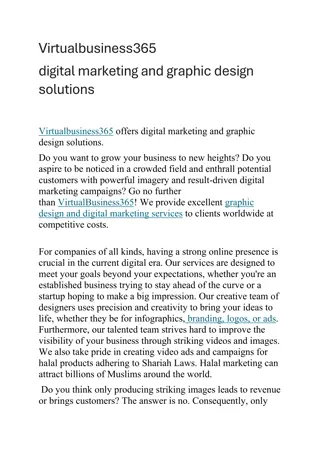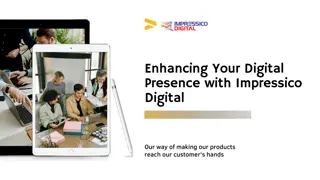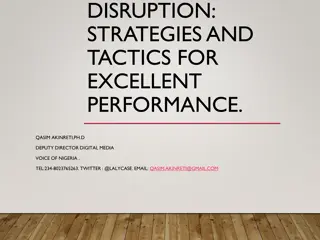
The Importance of Website Design: Crafting Engaging and Effective Digital Era
In todayu2019s digital-driven landscape, website design is a critical factor in determining the success of any online presence. Whether youu2019re a small business, a global corporation, or a personal brand, the design of your website acts as a vir
Download Presentation

Please find below an Image/Link to download the presentation.
The content on the website is provided AS IS for your information and personal use only. It may not be sold, licensed, or shared on other websites without obtaining consent from the author. Download presentation by click this link. If you encounter any issues during the download, it is possible that the publisher has removed the file from their server.
E N D
Presentation Transcript
The Importance of Website Design: Crafting Engaging and Effective Digital Experiences In today s digital-driven landscape, website design is a critical factor in determining the success of any online presence. Whether you re a small business, a global corporation, or a personal brand, the design of your website acts as a virtual storefront that shapes users first impressions, influences their behavior, and drives business results. In this article, we ll dive into the significance of website design, its key principles, and actionable tips to create visually appealing and user-friendly websites that stand out in a crowded digital space. What Is Website Design? Website design refers to the process of planning, conceptualizing, and creating the visual and functional aspects of a website. This includes elements such as layout, colors, fonts, images, navigation, and interactivity. The primary goal of website design is to ensure that a site is both aesthetically pleasing and easy to use, providing visitors with a seamless experience. Website design encompasses two main components: 1. UI (User Interface) Design: Focuses on the look and feel of the website, including graphical elements, typography, and overall layout. 2. UX (User Experience) Design: Ensures the website is intuitive, functional, and designed with the user s journey in mind. When done correctly, website design creates a harmonious blend of form and function, meeting both the user s needs and the site owner s objectives. Why Is Website Design Important? Investing in high-quality website design offers several benefits that go beyond aesthetics: 1. First Impressions Matter Your website is often the first interaction users have with your brand. A well-designed site establishes credibility and creates a positive initial impression. 2. Improves User Experience Intuitive navigation, fast loading times, and clear calls-to-action (CTAs) ensure visitors can easily find what they re looking for, enhancing their overall experience. 3. Boosts SEO Performance
Search engines favor well-structured, mobile-friendly websites with clean code and optimized elements. Good website design directly impacts your site s visibility in search engine results. 4. Increases Conversions Effective website design guides users toward desired actions, such as making a purchase, signing up, or contacting your business, ultimately boosting conversion rates. 5. Reflects Brand Identity Your website is a reflection of your brand. Consistent use of colors, fonts, and imagery communicates your brand s personality and builds trust. Key Principles of Effective Website Design To create a successful website design, consider these fundamental principles: 1. Simplicity Keep the design clean and uncluttered. Avoid overwhelming users with too many elements or excessive text. Focus on the essentials that convey your message effectively. 2. Mobile Responsiveness With mobile devices accounting for the majority of web traffic, your website must provide a seamless experience across all screen sizes. 3. Fast Loading Speeds A slow-loading website can lead to high bounce rates. Optimize images, leverage caching, and use efficient coding practices to ensure fast load times. 4. Consistent Branding Ensure that your logo, colors, fonts, and tone of voice are consistent across all pages. This reinforces brand recognition and credibility. 5. Clear Navigation Use intuitive menus and a logical structure to help users easily find the information they need. 6. Strong Visual Hierarchy Guide users attention to key elements like headlines, CTAs, and important content using size, color, and placement. 7. Accessibility
Design your website to be inclusive, ensuring it is usable by individuals with disabilities. This includes features like alt text for images, proper color contrast, and keyboard navigation. Tips for Crafting Exceptional Website Design 1. Understand Your Audience Research your target users to understand their preferences, needs, and behaviors. Tailor your design to resonate with your specific audience. 2. Prioritize Content Content is the backbone of your website. Ensure your design complements the content and makes it easy to consume. 3. Leverage White Space Strategic use of white space (empty areas) helps improve readability and gives your design a modern, uncluttered look. 4. Use High-Quality Visuals Incorporate professional images, videos, and graphics that align with your brand and enhance the user experience. 5. Test and Optimize Use A/B testing and gather user feedback to identify areas for improvement. Continuously refine your design to better meet user needs. Emerging Trends in Website Design Staying updated with design trends helps ensure your website remains modern and competitive. Here are some current trends in website design: 1. Dark Mode Offering users the option of a dark color scheme for reduced eye strain and modern aesthetics. 2. Minimalism Simpler designs with fewer distractions focus attention on key content and CTAs. 3. Microinteractions Small animations or effects that provide feedback and enhance user engagement. 4. 3D Elements Adding depth and realism to websites through 3D graphics and animations. 5. Voice-Activated Interfaces Integrating voice commands for smoother user interactions.
Tools for Designing Websites The right tools can streamline the website design process. Popular options include: Figma: For collaborative design and prototyping. Adobe XD: A versatile tool for wireframing and creating interactive designs. Canva: A user-friendly platform for quick visual creations. WordPress: A CMS platform with customizable themes for website design. Sketch: A powerful tool for vector-based UI design. The Role of Website Design in Business Growth High-quality website design is not just about creating a visually appealing site; it s a strategic asset that drives business growth. A well-designed website: Attracts and Retains Visitors: Keeps users engaged and encourages repeat visits. Generates Leads: Converts visitors into prospects through clear CTAs and forms. Builds Trust: Communicates professionalism and reliability. Supports Marketing Efforts: Complements SEO, social media, and email campaigns. Final Thoughts Investing in exceptional website design is a crucial step toward establishing a strong online presence. By combining visual appeal with functionality, you can create a website that not only captivates users but also drives measurable results. If you are searching for a creative website design service then OwnSaaS is a reliable option for you. Whether you re building a new site or revamping an existing one, focus on user experience, responsiveness, and branding to ensure your website meets the needs of your audience. Start prioritizing website design today and unlock the full potential of your online presence. Author: (Micheal Clark) Micheal Clark is a digital marketing expert having an experience of 7+ years in this industry. #WebsiteDesign, #WebDesign, #ResponsiveDesign, #ModernWebDesign, #UXDesign, #UserFriendlyDesign, #WebDesignTrends, #MobileFriendlyDesign, #SEOOptimizedDesign, #ProfessionalWebDesign, #CustomWebsiteDesign, #CreativeWebDesign, #FastLoadingWebsites, #WebsiteDesignTips, #WebsiteAesthetics, #WebDesignTools,
#WebDesignSolutions, #EffectiveWebDesign, #WebsiteUserExperience, #WebDevelopment, #DigitalDesign, #MinimalistWebDesign, #DarkModeDesign, #MicroInteractions, #WebDesignBestPractices






















